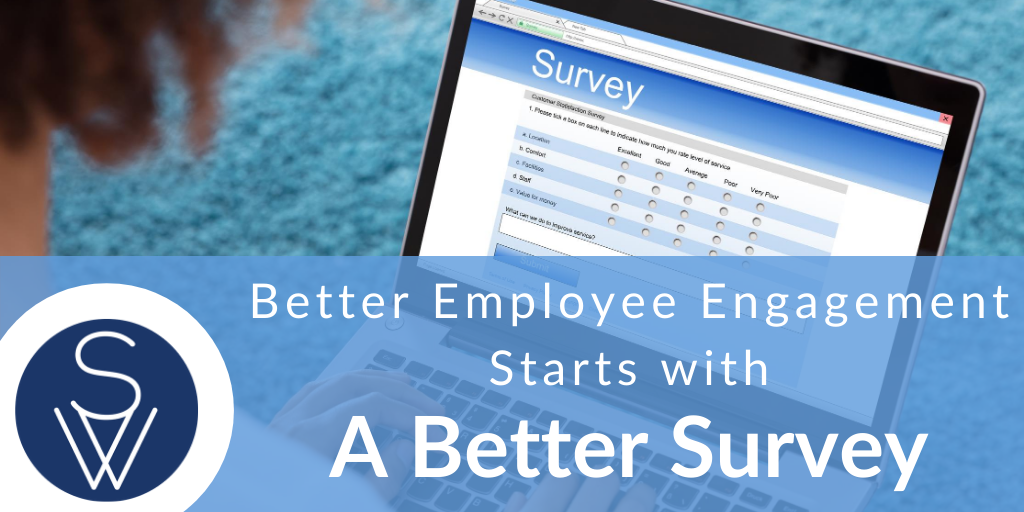
Over the past several years, the concept of “Employee Engagement” – and the practice of using surveys to measure it – has attracted a lot of attention among managers and the HR leadership who support them. It’s also generated a great deal of confusion. What is employee engagement? Isn’t it just a new name for employee satisfaction? We keep surveying them but nothing ever changes… why bother?
It’s that last question that I hear most often. My answer: if your survey results never improve, figure out why and fix the problem – but don’t stop measuring!
The truth is, a well-run survey can help you improve engagement. But a poorly planned survey will likely do more harm than good.
To get the most out of your next employee engagement survey, try the following 5 steps:
1. Understand Why Engagement Should be a Priority
When your employees are actually engaged with your company’s vision, with your department and with their own job, they’re more productive, and far more motivated to keep showing up and giving it their all. In other words, they’re less likely to be shopping around for a new job or employer. According to Gallup, companies with “highly engaged workforces” outperform their peers by 147%.
2. Commit to an Engagement Plan, Not Just the Survey
The survey is a measurement tool. You already know that. If you measure wisely, and take the time to interpret the findings accurately, you should have a roadmap for addressing areas of concern and improving engagement. But here’s something you may not have considered: the survey is a promise. When you ask your employees to take the time to tell you how they’re currently feeling about work, you’re saying that you care about their answers and, therefore, you’ll do something about what you learn. Employers who survey and survey and survey – and never manage to get back to respondents with an acknowledgement of what was shared and a concrete plan for moving forward – are actually doing great damage to their employees’ levels of engagement.
3. The survey becomes a powerful anti-engagement tool.
While you can’t have an action plan before you survey, be sure you’re ready to devise a plan that is transparent to your employees and holds you accountable. Follow the same SMART plan you (hopefully) use for your own employees: Specific, Measurable, Achievable, Realistic and Time bound.
4. Involve Your Executive Team, Especially the CEO
If you are the CEO, this is easy, but if you’re a department manager earnestly trying to gauge where your team is and willing to make the changes required, you need your senior management on board. When senior leaders don’t get behind the initiative, everyone else in the organization knows it and their trust falters. Before you survey, talk to your manager. Get their buy-in. Discuss the possible outcomes and the level of follow up and potential investment you’ll need from them.
5. Keep It Simple: Navigate The 7 C’s
Once you’re on a roll, you may be tempted to ask every single question you can imagine. Don’t give in to that temptation. Feeling trapped in a never-ending survey is extremely annoying. That’s not the feeling you’re aiming to create. Focus on a few key questions that are limited to the 7 C’s:
- Core Values: Do your employees actually know what your organization’s core values are? How do they see those values in action? What do they value most about working there?
- C-Suite Leadership: The quality of senior leadership has a profound effect on employee engagement. Do employees trust senior leadership? Do they hear clear, consistent messages from these leaders? Do they see senior managers clearly communicating and keeping their promises?
- Challenge and Motivation: What’s the challenge level of each employee’s work? Is it too hard for them? Too easy? A little boring? Or just right and highly motivating? Use this survey to find these things out.
- Career Path: Not every great employee wants a corner office. Some of your most wonderful contributors may need to stay right where they are for now. Others might be chomping at the bit to take things up a notch, boost their job title and bump up their salary. Do all of your employees have a clear view of the career paths available to them and whether you support them in the path they wish to pursue?
- Company Pride: Do your employees feel proud to tell others where they work? If not, why? People who take pride in their employer, take pride in their own work. It’s important to gauge that pride level and take immediate, transparent steps to fix it if it’s low. When someone feels embarrassed to name their employer, they’re looking for an exit ramp.
- Coworker Relationships: Do your employees trust each other? Do they respect each other’s skills, efforts and results? Do they trust that you address concerns when they’re brought to your attention? How would they rate the current talent level of their team?







